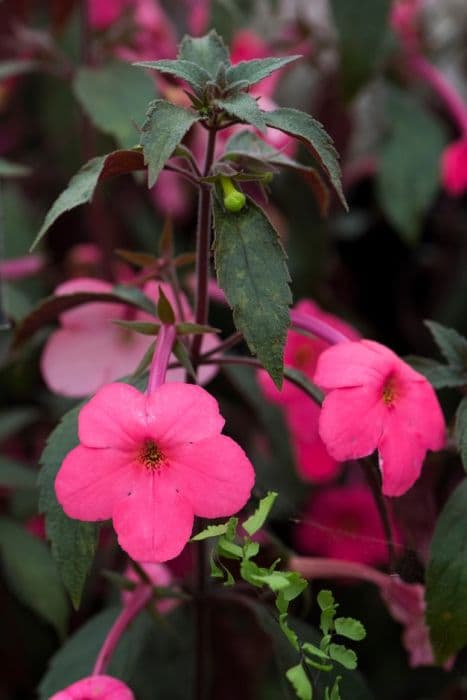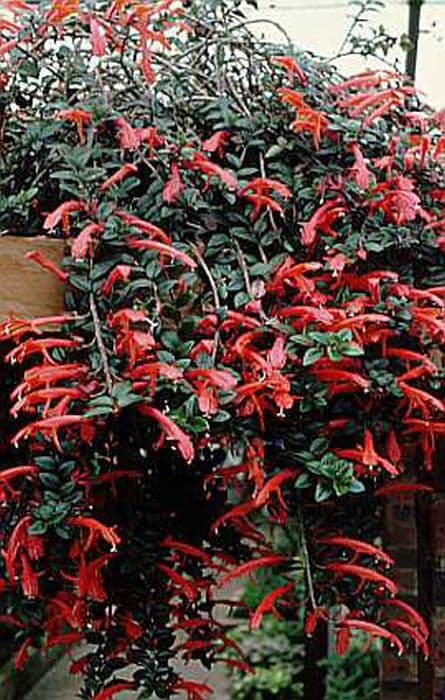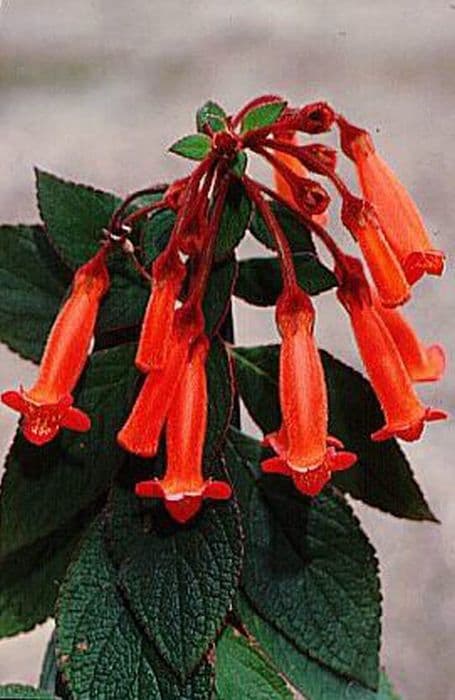Cape Primrose Streptocarpus 'Harlequin Blue' (PBR)

ABOUT
Streptocarpus 'Harlequin Blue' is known for its striking and vibrant flowers which have a combination of blue and purple hues. The blossoms feature a dramatic contrast of colors with deep blue or purple upper petals that are often highlighted with white or lighter blue streaks or spots, lending them a harlequin-like pattern. Below, the three lower petals may show a lighter shade, and the throat of the flower often has yellow or white markings which can draw attention to its open, trumpet-shaped form. The flowers emerge from slender, tube-like structures which then open up into the broad, flat petals that exhibit their colorful display. The blooms are arranged in clusters on short stalks that rise from the plant's base where the foliage forms a lush rosette. The leaves themselves are soft and velvety to the touch, deep green in color, and can be long and narrow with wavy or slightly ruffled edges. This plant exudes a dainty and delicate aesthetic, making it a popular choice for indoor decoration.
About this plant
 Names
NamesFamily
Gesneriaceae
Synonyms
Cape Primrose, African Violet
Common names
Streptocarpus 'Harlequin Blue' (PBR)
 Toxicity
ToxicityTo humans
The plant commonly known as Cape Primrose (Streptocarpus 'Harlequin Blue') is generally considered non-toxic to humans. There are no significant reports of toxic reactions in humans from ingesting or handling this plant. Therefore, no poisoning symptoms are typically associated with the Cape Primrose for humans.
To pets
Cape Primrose (Streptocarpus 'Harlequin Blue') is not known to be toxic to pets, including dogs and cats. This means that ingestion of this plant does not typically result in poisoning or serious health consequences for pets. While it is always best to prevent pets from ingesting plants as a precautionary measure, this particular species is not associated with toxic effects in pets.
 Characteristics
CharacteristicsLife cycle
Perennials
Foliage type
Evergreen
Color of leaves
Green
Flower color
Blue
Height
12 inches (30 cm)
Spread
18 inches (45 cm)
Plant type
Herb
Hardiness zones
10
Native area
South Africa
Benefits
 General Benefits
General Benefits- Easy to care for: Streptocarpus 'Harlequin Blue' requires moderate attention, making it suitable for gardeners of all levels.
- Long flowering period: This plant offers a long bloom time, often providing color from spring to fall.
- Compact size: Its small stature makes it an excellent choice for indoor spaces or small outdoor gardens.
- Vivid and colorful blooms: The striking blue flowers with their vivid patterns can add aesthetic appeal to any setting.
- Shade tolerance: It can grow well in partially shaded areas, where other flowering plants might struggle.
- Attracts pollinators: The blooms can attract beneficial pollinators like bees to your garden.
 Medical Properties
Medical PropertiesThis plant is not used for medical purposes.
 Air-purifying Qualities
Air-purifying QualitiesThis plant is not specifically known for air purifying qualities.
 Other Uses
Other Uses- Alternative Art Medium: Cape primrose petals can be pressed and used in floral art projects or to create natural dye for fabrics, adding a unique splash of color.
- Photography Subjects: Cape primrose, with its vibrant flowers, is ideal for macro photography to capture the beauty of nature in fine detail.
- Educational Tool: Cape primrose can be used in classrooms or educational programs to teach botany and the life cycle of flowering plants.
- Greeting Cards Decoration: Dried flowers of the Cape primrose can be used to embellish handmade paper or greeting cards.
- Living Centerpieces: Small potted Cape primroses can serve as living centerpieces for eco-friendly events or green weddings.
- Plant Science Experiments: They can be used to observe the effects of different fertilizers or growing conditions in a controlled experiment.
- Culinary Garnish: Although not commonly consumed, if confirmed as non-toxic, the petals could possibly be used as a delicate edible garnish for special dishes, after proper identification and safety checks.
- Theme Gardens: Cape primrose can be used to create themed gardens, like a "blue garden" or a "velvet-textured plant" garden due to its fuzzy leaves.
- Botanical Illustration: Artists may use the Cape primrose as a subject for botanical illustration, capturing its detail in a scientific or artistic manner.
- Seasonal Indoor Display: During the holidays, Cape primrose could be part of an indoor plant display, complementing the seasonal decor with its colorful blooms.
Interesting Facts
 Feng Shui
Feng ShuiThe Cape Primrose is not used in Feng Shui practice.
 Zodiac Sign Compitability
Zodiac Sign CompitabilityThe Cape Primrose is not used in astrology practice.
 Plant Symbolism
Plant Symbolism- Endurance: Streptocarpus, commonly known as Cape Primrose, often symbolizes endurance due to its ability to thrive with minimal care and bloom throughout the year, representing the strength to persevere in difficult conditions.
- Hope and Renewal: With its continuous blooming nature, Cape Primrose can represent hope and the renewal of life, as it brings consistent color and vibrancy, symbolizing optimism for the future.
- Long-lasting Friendship: The long-lived nature of individual Streptocarpus flowers can symbolize long-lasting relationships and friendships, as the plant maintains its beauty over long periods, reflecting enduring bonds between people.
 Water
WaterCape primrose, commonly known as Streptocarpus 'Harlequin Blue', prefers consistent moisture without becoming waterlogged. Water the plant deeply when the top inch of soil feels dry to the touch, which may be approximately once a week, depending on environmental conditions. Provide enough water to soak the soil, using about 8-16 ounces per watering session for a standard 6-inch pot, ensuring that excess water drains away. During periods of active growth in spring and summer, keep the soil slightly more moist. In fall and winter, reduce watering frequency to prevent root rot, as the plant requires less moisture when growth slows.
 Light
LightCape primrose thrives in bright, indirect light without direct sunlight, which can scorch its leaves. The best spot for this plant is near an east or north-facing window that receives morning light or filtered light throughout the day. Avoid placing it in dimly lit areas or where the sun's rays directly hit the foliage, which can hinder its growth and flowering.
 Temperature
TemperatureCape primrose enjoys temperatures between 60 to 75 degrees Fahrenheit during the day and should not be exposed to temperatures below 50 degrees at night, as cold temperatures can damage the plant. The ideal growing conditions for this plant are in a consistently warm environment, away from drafts and sudden temperature changes, ensuring it remains within this temperature range for optimal health and flowering.
 Pruning
PruningRegularly remove spent blooms and yellowing or dead leaves from Cape primrose to maintain its appearance and encourage more blooms. Pruning should be done as needed throughout the growing season to promote healthy growth. The best time for a more thorough pruning is in early spring or after the main flowering period to help rejuvenate the plant and shape it for the upcoming growth cycle.
 Cleaning
CleaningAs needed
 Soil
SoilCape Primrose requires a light, well-draining soil mix with a pH of 6.0 to 7.0, rich in organic matter. A mixture of peat, perlite, and vermiculite in equal parts is ideal to provide the necessary drainage and aeration.
 Repotting
RepottingCape Primrose should be repotted every year or when it outgrows its container, typically seen when roots start emerging from the pot's drainage holes.
 Humidity & Misting
Humidity & MistingCape Primrose thrives best at a humidity level of 40-60%. It enjoys moist air but can tolerate lower humidity levels if not too dry.
 Suitable locations
Suitable locationsIndoor
Provide bright indirect light and keep evenly moist.
Outdoor
Protect from direct sun; sheltered spot; keep soil moist.
Hardiness zone
10-11 USDA
 Life cycle
Life cycleThe cape primrose 'Harlequin Blue' begins its life as a seed, germinating in moist, well-drained soil with plenty of warmth and indirect sunlight. After sprouting, it enters the vegetative stage, developing a rosette of fuzzy, dark green leaves and growing steadily with regular watering and good light. Following the vegetative stage, it matures and enters the flowering phase when the daylight hours are longer, producing vivid blue and throat-patterned blossoms that attract pollinators. Post-pollination, if successful, leads to seed formation, allowing for the propagation and continuation of the species. Finally, as a perennial, after the flowering season, the cape primrose 'Harlequin Blue' enters a dormancy phase where growth slows, and it requires less water, preparing to repeat the cycle once favorable conditions return.
 Propogation
PropogationPropogation time
Spring-Early Summer
The most popular method of propagating Streptocarpus 'Harlequin Blue', commonly known as Cape Primrose, is through leaf cuttings. The best time to take leaf cuttings is in the spring or early summer, when the plant is actively growing. A healthy, mature leaf is selected and cut across the width, preferably into sections about 2 to 3 inches (5 to 7.5 centimeters) long. Each section should contain a vein. The cuttings are then placed in a moist potting mix with the cut edge slightly buried. Indirect light and consistent humidity are essential for encouraging rooting, which can take a few weeks. Once the cuttings have rooted and new growth appears, they can be gently potted on into individual containers.









